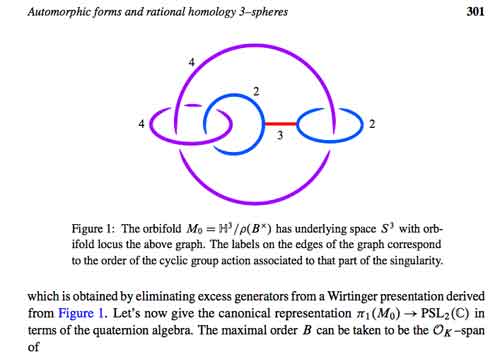Towards the end of the Bost-Connes for ringtheorists post I freaked-out because I realized that the commutation morphisms with the $X_n^* $ were given by non-unital algebra maps. I failed to notice the obvious, that algebras such as $\mathbb{Q}[\mathbb{Q}/\mathbb{Z}] $ have plenty of idempotents and that this mysterious ‘non-unital’ morphism was nothing else but multiplication with an idempotent…
Here a sketch of a ringtheoretic framework in which the Bost-Connes Hecke algebra $\mathcal{H} $ is a motivating example (the details should be worked out by an eager 20-something). Start with a suitable semi-group $S $, by which I mean that one must be able to invert the elements of $S $ and obtain a group $G $ of which all elements have a canonical form $g=s_1s_2^{-1} $. Probably semi-groupies have a name for these things, so if you know please drop a comment.
The next ingredient is a suitable ring $R $. Here, suitable means that we have a semi-group morphism
$\phi~:~S \rightarrow End(R) $ where $End(R) $ is the semi-group of all ring-endomorphisms of $R $ satisfying the following two (usually strong) conditions :
-
Every $\phi(s) $ has a right-inverse, meaning that there is an ring-endomorphism $\psi(s) $ such that $\phi(s) \circ \psi(s) = id_R $ (this implies that all $\phi(s) $ are in fact epi-morphisms (surjective)), and
-
The composition $\psi(s) \circ \phi(s) $ usually is NOT the identity morphism $id_R $ (because it is zero on the kernel of the epimorphism $\phi(s) $) but we require that there is an idempotent $E_s \in R $ (that is, $E_s^2 = E_s $) such that $\psi(s) \circ \phi(s) = id_R E_s $
The point of the first condition is that the $S $-semi-group graded ring $A = \oplus_{s \in S} X_s R $ is crystalline graded (crystalline group graded rings were introduced by Fred Van Oystaeyen and Erna Nauwelaarts) meaning that for every $s \in S $ we have in the ring $A $ the equality $X_s R = R X_s $ where this is a free right $R $-module of rank one. One verifies that this is equivalent to the existence of an epimorphism $\phi(s) $ such that for all $r \in R $ we have $r X_s = X_s \phi(s)(r) $.
The point of the second condition is that this semi-graded ring $A$ can be naturally embedded in a $G $-graded ring $B = \oplus_{g=s_1s_2^{-1} \in G} X_{s_1} R X_{s_2}^* $ which is bi-crystalline graded meaning that for all $r \in R $ we have that $r X_s^*= X_s^* \psi(s)(r) E_s $.
It is clear from the construction that under the given conditions (and probably some minor extra ones making everything stand) the group graded ring $B $ is determined fully by the semi-group graded ring $A $.
what does this general ringtheoretic mumbo-jumbo have to do with the BC- (or Bost-Connes) algebra $\mathcal{H} $?
In this particular case, the semi-group $S $ is the multiplicative semi-group of positive integers $\mathbb{N}^+_{\times} $ and the corresponding group $G $ is the multiplicative group $\mathbb{Q}^+_{\times} $ of all positive rational numbers.
The ring $R $ is the rational group-ring $\mathbb{Q}[\mathbb{Q}/\mathbb{Z}] $ of the torsion-group $\mathbb{Q}/\mathbb{Z} $. Recall that the elements of $\mathbb{Q}/\mathbb{Z} $ are the rational numbers $0 \leq \lambda < 1 $ and the group-law is ordinary addition and forgetting the integral part (so merely focussing on the ‘after the comma’ part). The group-ring is then
$\mathbb{Q}[\mathbb{Q}/\mathbb{Z}] = \oplus_{0 \leq \lambda < 1} \mathbb{Q} Y_{\lambda} $ with multiplication linearly induced by the multiplication on the base-elements $Y_{\lambda}.Y_{\mu} = Y_{\lambda+\mu} $.
The epimorphism determined by the semi-group map $\phi~:~\mathbb{N}^+_{\times} \rightarrow End(\mathbb{Q}[\mathbb{Q}/\mathbb{Z}]) $ are given by the algebra maps defined by linearly extending the map on the base elements $\phi(n)(Y_{\lambda}) = Y_{n \lambda} $ (observe that this is indeed an epimorphism as every base element $Y_{\lambda} = \phi(n)(Y_{\frac{\lambda}{n}}) $.
The right-inverses $\psi(n) $ are the ring morphisms defined by linearly extending the map on the base elements $\psi(n)(Y_{\lambda}) = \frac{1}{n}(Y_{\frac{\lambda}{n}} + Y_{\frac{\lambda+1}{n}} + \ldots + Y_{\frac{\lambda+n-1}{n}}) $ (check that these are indeed ring maps, that is that $\psi(n)(Y_{\lambda}).\psi(n)(Y_{\mu}) = \psi(n)(Y_{\lambda+\mu}) $.
These are indeed right-inverses satisfying the idempotent condition for clearly $\phi(n) \circ \psi(n) (Y_{\lambda}) = \frac{1}{n}(Y_{\lambda}+\ldots+Y_{\lambda})=Y_{\lambda} $ and
$\begin{eqnarray} \psi(n) \circ \phi(n) (Y_{\lambda}) =& \psi(n)(Y_{n \lambda}) = \frac{1}{n}(Y_{\lambda} + Y_{\lambda+\frac{1}{n}} + \ldots + Y_{\lambda+\frac{n-1}{n}}) \\ =& Y_{\lambda}.(\frac{1}{n}(Y_0 + Y_{\frac{1}{n}} + \ldots + Y_{\frac{n-1}{n}})) = Y_{\lambda} E_n \end{eqnarray} $
and one verifies that $E_n = \frac{1}{n}(Y_0 + Y_{\frac{1}{n}} + \ldots + Y_{\frac{n-1}{n}}) $ is indeed an idempotent in $\mathbb{Q}[\mathbb{Q}/\mathbb{Z}] $. In the previous posts in this series we have already seen that with these definitions we have indeed that the BC-algebra is the bi-crystalline graded ring
$B = \mathcal{H} = \oplus_{\frac{m}{n} \in \mathbb{Q}^+_{\times}} X_m \mathbb{Q}[\mathbb{Q}/\mathbb{Z}] X_n^* $
and hence is naturally constructed from the skew semi-group graded algebra $A = \oplus_{m \in \mathbb{N}^+_{\times}} X_m \mathbb{Q}[\mathbb{Q}/\mathbb{Z}] $.
This (probably) explains why the BC-algebra $\mathcal{H} $ is itself usually called and denoted in $C^* $-algebra papers the skew semigroup-algebra $\mathbb{Q}[\mathbb{Q}/\mathbb{Z}] \bowtie \mathbb{N}^+_{\times} $ as this subalgebra (our crystalline semi-group graded algebra $A $) determines the Hecke algebra completely.
Finally, the bi-crystalline idempotents-condition works well in the settings of von Neumann regular algebras (such as all limits of finite dimensional semi-simples, for example $\mathbb{Q}[\mathbb{Q}/\mathbb{Z}] $) because such algebras excel at idempotents galore…




